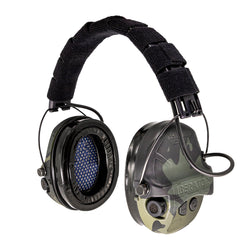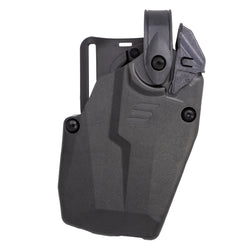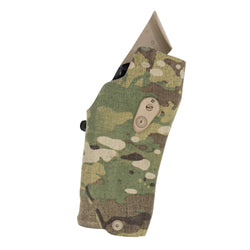When you picture a gas mask, what comes to mind? For most, it’s an image straight out of a war movie. Soldiers advancing through a smoky haze or maybe a dramatic scene of a figure in a full-body hazmat suit cleaning up a toxic spill. Some of us may even picture a scientist with wild hair, goggles, and a respirator, cackling over a bubbling beaker of some glowing, dangerous chemical.
These images firmly plant gas masks in the realm of “specialized equipment” for “specialized professionals.” But what if that perception is just wrong? What if a gas mask, or more accurately, an air-purifying respirator, is a practical piece of emergency gear for everyday citizens like you and me?

People often view gas masks as extreme and assume only “professionals” should have them. But in an unpredictable world, having the ability to protect your lungs from airborne threats might not be such a far-fetched idea. Isn’t there an old saying that goes, “It’s better to have it and not need it than to need it and not have it?”
For those new to the idea of owning a gas mask, here is a quick guide to understanding them.
Why Would I Need a Gas Mask?
As I mentioned above, the idea of needing a gas mask in the United States might seem extreme. But multiple scenarios could make it an important survival tool. Our world operates around the unknown, and being prepared for the unknown should be a part of our daily lives. This is why we have emergency kits and often make preparedness plans for those unknown disasters.
Terror attacks
One of the most cited reasons to own a gas mask is the potential for a terrorist attack. While we hope this never happens to us, we all know terrorist attacks can and do happen. Some experts even say a terror attack is only a matter of time for the US.

Major cities and infrastructure will always be a potential target for chemical or biological agents. A device that can filter out these deadly substances could be lifesaving in the immediate aftermath, allowing you to evacuate a contaminated area safely.
Natural disasters
Natural disasters also present a significant risk. Wildfires are becoming more frequent and intense, blanketing vast areas with thick, toxic smoke for weeks. This smoke contains fine particulate matter that can cause severe respiratory damage.

For parts of the country, volcanic eruptions can spew ash and harmful gases, like sulfur dioxide, into the atmosphere, making the air unbreathable.
Even massive dust storms in arid regions can fill the air with particles that can overwhelm your respiratory system quickly.
Industrial accidents
Industrial accidents are also a constant concern for localized threats. The United States has a massive industrial and transportation network. A train derailment carrying toxic chemicals, like we saw on February 3, 2023, is a good example. In this incident, a freight train derailed, causing multiple hazardous chemicals to spill. One of these chemicals was vinyl chloride, which burns as it vaporizes.
The town of East Palestine, Ohio, was ordered to evacuate the area. What if this happened in the middle of a highly populated area?
Civil unrest
Another type of event we are starting to see more and more of is civil unrest. As these types of events take place, the use of crowd-control agents like tear gas and pepper spray is becoming more common. Of course, this is not something that should be used to participate in illegal protests, but for those trying to get home, a gas mask could be a good option.
While not typically lethal, these agents are debilitating, and a gas mask will protect you if you are inadvertently caught in or need to move through the affected area.
What Will Gas Masks Protect Against?
Understanding what a gas mask can and cannot do is important if you plan to own one. I often caution people about using a gas mask as a “feel safe” item. If you are going to own one, you need to know how to use it and understand its limitations. Just buying one so you feel safe and sticking it in your closet is not recommended.
A gas mask is basically a well-fitting, air-tight facepiece with a viewing lens and a port for a filter. The mask is only as good as its seal and, just as importantly, the filter attached to it. The filter is the “battery” if you will. This is the item that must be attached to make it work, and swapped out from time to time.

Filters, often called canisters or cartridges, determine what contaminants are removed. There isn’t one “do-it-all” filter, but some come very close. For general emergency preparedness, most experts recommend a “CBRN” rated filter. CBRN stands for Chemical, Biological, Radiological, and Nuclear. These advanced filters are designed to protect against a wide range of threats that include:
- Chemical: This includes traditional chemical warfare agents like nerve agents (Sarin, VX), blister agents (mustard gas), and toxic industrial chemicals (ammonia, chlorine). Filters have ratings, such as the NIOSH (National Institute for Occupational Safety and Health) color-coding system, to indicate which chemicals they handle.
- Biological: A CBRN filter with a P100 particulate rating is highly effective against biological threats. The “P100” means it filters out 99.97% of airborne particles, including bacteria (like anthrax) and viruses. This makes it a valuable tool in the face of a bioterrorism event.
What about radiation?
This is a common point of confusion. A gas mask with a CBRN/P100 filter can protect you from inhaling radioactive particles, often called radiological dispersal devices or “dirty bombs.”
If nuclear fallout is present in the air as dust or ash, the filter will prevent you from breathing it in. However, a gas mask offers no protection against gamma radiation itself, which can pass through the mask and your body. It protects your respiratory system from particulate contamination, which is an important part of surviving a nuclear event. Just be aware, it is not a magic shield against all forms of radiation.
Buying canisters/filters
There are multiple brands and places to purchase filters, but I like to use MIRA filters. They are affordable and a well-respected maker of masks and filters.
For general survival and emergencies, I like to use the NBC-17 filter. This is a NATO/40mm lightweight CBRN filter with a 10-year shelf-life. It is compliant for European agencies and carries an EN 14387+A1 rating (sets a standard for gas mask filters).

If you want other filters for specific purposes, they make those too. The ParticleMax p3 Virus filter is rated for use with long-term pandemic incidents. For $160, you get six filters with a 20-year shelf life.
Where Do You Get a Gas Mask?
Once you’ve decided to add a gas mask to your gear, the next step is finding one you feel meets your expectations. Like guns, ammo, or anything else, there are a ton of options out there. Some good, some not so good. When it comes to gas masks, however, I would recommend buying a good one. It’s pointless to have one that doesn’t work correctly, isn’t it?
As I mentioned with the filters, I like to use MIRA Safety because they offer a wide range of products. The one I use the most is the CM-6M model. I’ve used this mask for work (law enforcement), and it will be my go-to emergency gas mask.
A lot of military and police around the world use the CM-6M gas masks, so they have been tested in the field before. Prices for a mask alone typically range between $250 to $350. CBRN filters normally cost around $50-$80 each.

Another top-tier brand is Avon Protection, a UK-based company that is a major supplier to the U.S. military. Their M50/FM50 mask is considered a gold standard, but it comes at a premium price. These masks often exceed $800 from retailers like Galls. Due to its use by the military, availability can sometimes be restricted.
Are there budget gas masks?
For those on a more modest budget, brands like Parcil Safety offer NIOSH-approved respirators. Models like the ST-100X full-face mask provide excellent protection against industrial threats and particulates for under $150. It works with any NATO/40mm style filters just like the others.
While not always fully CBRN-rated, this one is a significant step up from basic hardware store respirators.

When looking for a mask, I would avoid surplus stores or used masks unless you can verify the condition, manufacturing date, and expiration date.
How should you store your gas mask?
Owning a gas mask is only half the battle; knowing how to use and maintain it is just as important. Having the best of the best is pointless if you don’t know how to use it, store it, or carry it.
Your gas mask and its filters should be stored in a cool, dark, and dry place, away from direct sunlight and extreme temperatures. Think about how you store your ammo… You don’t want it in a hot attic or damp basement, do you?
The original carrying case or a dedicated sealed bag is ideal. Most importantly, filters should remain in their factory-sealed packaging until the moment you need them. Once the seal is broken, the filter’s shelf life begins to diminish as it starts absorbing moisture and trace contaminants from the ambient air. A filter that has been open for months or years will not be reliable when you need it most.
I keep my gas mask in an airtight container with some filters and a gear bag for the bask. The gear bag will attach to MOLLE or around your thigh, with a belt loop at the top. This allows me to carry the mask with me if I decide it’s needed.
Putting on your gas mask
- Inspect the Mask First: Make sure your gas mask isn’t cracked, ripped, or missing any seals. Also, check that the filter is attached securely and hasn’t expired
- Remove Headgear: If you’re wearing a hat, helmet, or your collection of tactical operator patches—take them off. Make sure any hair is out of the way so you get a good seal.
- Position the Mask: Hold the mask in both hands with the straps dangling. Then, put your chin in the chin cup or the bottom of the mask first. Hold your breath and tilt the mask up onto your face, covering your nose and eyes.
- Pull the Straps Over Your Head: Grab the harness (the rubber spider-looking thing on the back) and pull it over the crown of your head.
- Tighten the Straps: Start with the bottom straps (near your neck) and pull them back. Then move up to the temple straps and then the top. Tighten them evenly but don’t crank one side down so hard you give yourself a facelift on only half your face. Exhale to push any contaminated air out of the mask and filter

Once it is one, check the seal
- Seal Check (Very Important): Cover the filter inlet(s) with your palm or plug them with your hand and inhale gently. The mask should suck tight against your face and stay there. If air leaks in, adjust and retighten.
- Breathe Normally: Once you have a good seal, you can breathe like a normal human being, or at least as normal as you can with a rubber bucket on your face.
- Work on Speed: In emergencies, you want to be able to do this in about 10 seconds or less. Practice until you can get it on quickly without fumbling around like you’re trying to put on a Halloween mask in the dark.

Changing Filters
Filters have a limited lifespan. How often you need to change one depends on the type and concentration of the contaminant. In a heavily contaminated environment, a filter might only last a few hours. You may notice it becomes difficult to breathe, or you might begin to taste or smell the contaminant, which is a critical sign that your filter is saturated and must be changed immediately.
If you have spare filters, you should move to an uncontaminated area to change them if possible. If not, the process must be done quickly.
To do this, hold your breath, unscrew the old filter, screw on the new one, and check the seal. This is a last resort action and requires significant practice. For most people, the goal is to use the mask to escape a dangerous area, not to operate within it for extended periods.
Is a gas mask right for you?
As I mentioned in the beginning, a gas mask feels like an extreme measure to some people. This is partially because of how they have been portrayed in movies. In all reality, a gas mask is nothing more than a safety device. During an unforeseen emergency, it can save your life.
One thing to keep in mind that I have not mentioned yet is the location of the filter on the mask. The filter is located in various locations on different types of masks. Depending on this location, it may be hard to use the sighting system on a rifle while wearing the mask.
Because of this, I like to use a mask where the filter is located on the left side. I am right-handed, so this provides enough room for me to use my optic without the filter getting in the way.
If you decide it’s time to add a gas mask to your EDC, emergency, or apocalypse gear, treat it like any other equipment. Find what works for you, practice with it, and have a plan in place.









